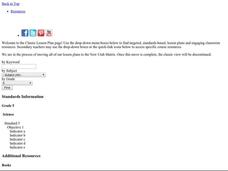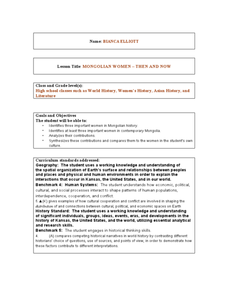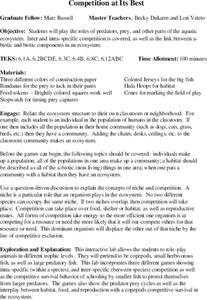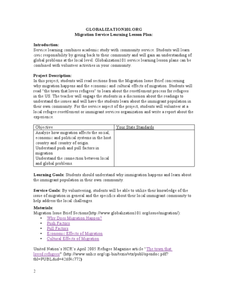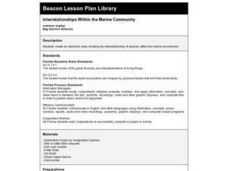Curated OER
World Hunger
Students research the causes and effects of world hunger on children. In this world hunger lesson, students discuss causes and effects of hunger around the world and research a specific area affected by hunger. Students prepare a...
Curated OER
Peanut Butter Broccoli
Fifth graders explore food production by viewing DNA presentations. In this genetic engineering lesson, 5th graders discuss the foods they typically eat at home and how many common foods are engineered in a way that can produce a bigger...
Curated OER
Rock, Paper, Scissors
Fifth graders explore genetic traits. For this genetic traits lesson, 5th graders investigate dominant and recessive traits. Students identify similar traits between a parent organism and its offspring.
Curated OER
Interviewing Skills
Prepare your pupils for the world of work and the dreaded interview by providing class members with a resource packet that includes handy tips. After examining the materials, pairs conduct mock interviews and reflect on the experience....
Curated OER
Exploring Ecology
Students explore the basics of ecology through numerous hands-on and relevant activities. They participate in an online food chain demonstration, which explores food web dynamics. They dissect owl pellets, examine the prey's bones, and...
Curated OER
Marine Animals on the Move
Students complete a project based on collecting satellite data aimed at finding connections between organisms and the environment. They create a final project working with a partner to share with the class.
Curated OER
Stereotypes
Third graders define the word stereotypes and identify various examples. In groups, they discuss what they can gather about life and society from other culture groups. They also describe factors that cause conflict and cooperation among...
Curated OER
MONGOLIAN WOMEN - THEN AND NOW
Students are introduced to the history of Mongolia. This is a general overview before going into the real detail of the lesson. The main focus is upon the development of the women of Mongolia and the major contributions they have made.
Curated OER
ProjectWILD Aquatic: Migration Headache
Learners explore the important factors that affect habitat quality and the associated survival of migratory water bird populations. They discuss an organisms dependency upon a variety of habitats and habitat quality. Students play a game...
Curated OER
Compettion at its Best
Sixth graders role play predators, prey and other parts of the aquatic ecosystem. They show inter and intra-specific competition as well as the link between abiotic and biotic components in an ecosystem. Students play games about the...
Curated OER
Science: 4 X 4
Young scholars generate four statements and four questions based on their current level of understanding of the article from the engage lesson. They
evaluate the statements and questions that they have generated and those of their...
Curated OER
International Summit on Asia
Middle schoolers consider different aspects of Asia to determine which Asian country they think would be the best location for the American business development. They engage in a series of lessons designed to examine regions of Asia,...
Curated OER
What is Migration
Young scholars conduct individual research and participate in discussion be able to identify difference between forced and voluntary migration. They identify if push and pull factors are caused by political, social, economic, or...
Curated OER
Migration Service Learning Lesson Plan
Students examine how migration affects different aspects of countries. They identify push and pull factors and participate in a service learning project to discover how local and global problems connect.
Curated OER
Sweethearts and Data Analysis
Students explore the concept collecting and representing data. In this collecting and representing data lesson, students record the different colors of sweetheart candies in their sweethearts box. Students create a table of the data and...
Curated OER
Retirement: Show Me the Money!
Learners explore the concept of retirement finances. In this retirement finances lesson, students discuss what it means to save, invest, risk, or the time value of money. Learners play the stock market game. Students interview a parent...
Curated OER
Fertilizers, Pesticides and Human Health- American Lessons
High schoolers explore migration and why people move. They explore the movement of native populations. Students explore the economy as an factor in migration. They discuss the exploitation of the migrant worker.
Curated OER
My Journey From Innocence
Students discuss the factors that may or may not influence the outcome of a sexual experience. After reading a brief article about a student losing their virginity, students discuss the ways a sexual experience can have a different...
Alabama Learning Exchange
Factoring by Mack
Learners explore the concept of factoring trinomials. In this factoring trinomials lesson, students use the Mack Method to factor trinomials. Learners watch a video on how to factor a trinomial with a coefficient of 1 with...
Curated OER
"The Rajah's Rice: A Mathematical Folktale from India" adapted by David Barry
Pupils use large numbers and learn exponential representation and explain patterns and relations of powers of 2.
Curated OER
Interrelationships Within the Marine Community
Fourth graders create an electronic story showing the interrelationship of species within the marine environment. They utilize the educational software, 'Destination Ocean' during this engaging lesson.
Curated OER
Web of Life - Ecosystem
Third graders play the roles of various organisms in an ecosystem (focusing on insects) and pass yarn or string around to other organisms from largest animals to the smallest. The end product is a web which shows how all of these animals...
Curated OER
Tools of the Historian: Frame of Reference
Students discuss the term point of reference and describe their own point of view. They compare the relationship between sources and the historical context. They identify examples of how point of reference can affect one's interpretation.
Curated OER
Creating New Animals
Learners navigate an interactive web site to create imaginary animals. They research one or more animals. They create one page report with pictures. They discuss attributes of animals they have researched.




